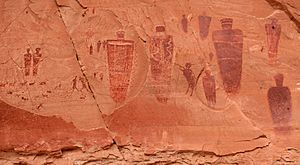Horseshoe Canyon (Utah) facts for kids
Horseshoe Canyon, once known as Barrier Canyon, is a special place in Utah, United States. It is located far away from cities, west of the Green River. It is also north of the Maze District in Canyonlands National Park.
This canyon is famous for its amazing collection of Barrier Canyon Style rock art. This art includes both pictographs (paintings) and petroglyphs (carvings). This unique art style was first identified here. A part of Horseshoe Canyon, which includes The Great Gallery, is now part of Canyonlands National Park. This area was added to the park in 1971. This was done to help protect the ancient rock art found throughout the canyon.
Contents
History of Horseshoe Canyon
People have lived in Horseshoe Canyon for a very long time. The earliest signs of humans date back to 9000-7000 B.C. During this time, Paleo-Indians hunted large animals. These animals included mastodons and mammoths across the southwestern United States.
Later, other groups of people lived here. These included the Desert Archaic culture, the Fremont culture, and Ancestral Puebloans. The Fremont and Ancestral Puebloans stayed for a shorter time. It is believed that Native American people left the canyon by about 1300 A.D.
The Great Gallery's Ancient Art
The Great Gallery is one of the largest and best-preserved collections of Barrier Canyon Style rock art. The art in this gallery was made by the Desert Archaic culture. These people were nomadic hunter-gatherers. They moved around to find food and did not live in one place.
The art panel itself is very large. It measures about 200 feet (61 meters) long and 15 feet (4.5 meters) high. The panel shows about 20 human-like figures. These figures are life-sized, and the tallest one is over 7 feet (2.1 meters) tall.
A copy of these paintings was made by the Works Projects Administration. You can see this copy at the Natural History Museum of Utah. Scientists have studied the Holy Ghost panel in the Great Gallery. They believe it was created between 400 A.D. and 1100 A.D. This was figured out by looking at rockfall events that happened around the art.
Visiting Horseshoe Canyon

The starting point for hikes into Horseshoe Canyon is on the west rim. You can reach it from State Route 24. This involves driving about 30 miles (48 km) on a dirt road. You can also get there from Green River, which is about 47 miles (76 km) on a dirt road. Some parts of these dirt roads can become difficult to drive on when it rains.
Visitors can camp at the west rim trailhead. This area is public land managed by the Bureau of Land Management, also known as BLM. There is a toilet available, but there is no water. Please remember that you cannot camp overnight inside Horseshoe Canyon within the Park boundaries.
Hiking to the Great Gallery
To see the rock art, you need to hike down into the canyon. The trail drops about 750 vertical feet (228 meters) to the canyon bottom. From there, you hike about 3 miles (4.8 km) to reach the art.
The round trip hike from the West Rim trailhead to the Great Gallery is about 6.5 miles (10.5 km). It usually takes 3 to 6 hours to complete. The trail is marked fairly well. However, reaching the Great Gallery requires good energy and strength. This is especially true when it is hot. You will pass three other important rock art panels on your way to the Great Gallery.
See also
 In Spanish: Cañón de la Herradura (Utah) para niños
In Spanish: Cañón de la Herradura (Utah) para niños



